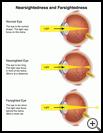
Nearsightedness: Corneal Ring Treatment
________________________________________________________________________
KEY POINTS
- An intrastromal corneal ring is a plastic ring that is surgically inserted into the clear outer layer on the front of the eye. This ring corrects nearsightedness and helps you see distant objects clearly. The rings can be replaced if your vision changes.
- Ask your provider how long it will take to recover and how to take care of yourself at home.
- Make sure you know what symptoms or problems you should watch for and what to do if you have them.
________________________________________________________________________
What is a corneal ring?
An intrastromal corneal ring (ICR) is a ring of plastic that is surgically inserted into an outer layer of your cornea, which is the clear outer layer on the front of the eye. This ring corrects nearsightedness and helps you see distant objects clearly.
Nearsightedness means that you see close objects clearly, but distant objects are blurry. This happens when the eyeball is too long or when the outer layer of the eye, called the cornea, is too curved. This causes light rays to focus at a point in front of the light-sensitive tissue at the back of the eye (retina) instead of directly on it.
When is it used?
An ICR is most often used to treat keratoconus, a disease where the cornea takes on an abnormal cone shape. ICR is sometimes used to treat mild to moderate nearsightedness. Unlike LASIK or PRK procedures, ICR surgery can be reversed or the rings replaced if your vision changes.
After this procedure, you may not need glasses for distance vision. If you still need glasses, you may be able to have thinner lenses. Most people (97% in some studies) have vision of 20/40 or better without glasses after the procedure.
Ask your healthcare provider about your choices for treatment and the risks.
How do I prepare for this procedure?
- Plan for your care and a ride home after the procedure.
- You may or may not need to take your regular medicines the day of the procedure. Tell your healthcare provider about all medicines and supplements that you take. Some products may increase your risk of side effects. Ask your healthcare provider if you need to avoid taking any medicine or supplements before the procedure.
- Do not wear eye makeup on the day of the surgery.
- Follow any other instructions your healthcare provider gives you.
- Ask any questions you have before the procedure. You should understand what your healthcare provider is going to do. You have the right to make decisions about your healthcare and to give permission for any tests or procedures.
What happens during the procedure?
Your provider numbs your eye with special eye drops. Then the provider makes small cuts in the outer edge of the cornea. Starting at these cuts, the provider makes tunnels under the outer layer of the cornea to hold the sections of the ring. The provider inserts both sections of the ring into the tunnels and closes the cuts with one or more stitches. The ring flattens the cornea. Light rays then focus on or closer to the retina, which improves your vision.
Usually, one eye is done at a time.
What happens after the procedure?
Do not rub your eye at any time after the procedure.
You will feel some discomfort, which may last for a day or two. Your provider may put a patch on your eye. He or she will examine your eye the next day.
Your provider may give you medicine to treat swelling, pain, infection, redness, and irritation. Use all your medicines exactly as prescribed. Keep all your appointments for checkups and removing your stitches. If you still need glasses, ask your eye care provider when you should be tested for new lenses. You cannot wear some types of contact lenses after you have had an ICR.
Your provider may tell you to wear an eye shield at night to protect against injury or rubbing while you are asleep.
Ask your healthcare provider:
- How long it will take to recover
- If there are activities you should avoid
- How to take care of yourself at home and when you can return to your normal activities
- What symptoms or problems you should watch for and what to do if you have them
Make sure you know when you should come back for a checkup. Keep all appointments for provider visits or tests.
What are the risks of this procedure?
Every procedure or treatment has risks. Some possible risks of this procedure include:
- Your eyes may be over-corrected, and you may become farsighted. Your provider can remove corneal rings if they cause problems, or replace them with rings of a different size if needed. After the rings are removed, you can wear glasses or contacts.
- You may not get enough correction and still need glasses for distance vision. You may find that the best vision you can have is worse than before the procedure.
- You may have scarring that causes halos or glare in your field of vision and reduced night vision.
- You may need reading glasses for close vision. After eye surgery some people need to begin using reading glasses sooner than they would have without it. (Most people need reading glasses after about age 40 because of changes in their eyes as they get older.)
- You may develop an infection.
- You may have an increase in astigmatism (blurred vision caused by an uneven curve in your cornea, which is the clear outer layer on the front of the eye).
- You may have double vision.
Ask your healthcare provider how these risks apply to you. Be sure to discuss any other questions or concerns that you may have.

